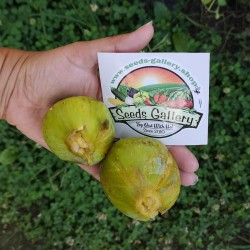Menu
-
MenuTerug
- Home
-
Categorieën
-
-
Categorieën
-
Groentezaden
-
Rassen per land
- Soorten uit Armenië
- Rassen uit BiH
- Rassen uit Kroatië
- Rassen uit Frankrijk
- Varieties from Germany
- Varieties from Greece
- Varieties from Hungary
- Rassen uit India
- Varieties from Italy
- Rassen uit Japan
- Rassen uit Noord-Macedonië
- Varieties from Peru
- Varieties from Russia
- Varieties from Serbia
- Rassen uit Slovenië
- Varieties from Spain
- Varieties from Thailand
- Rassen uit Turkije
- Varieties from USA
- Tomatenzaden
- Maïs zaden
- Kalebas familie
- Bean familie
- Komkommerzaden
- Paprika Zaden
- Wortelfamilie
- Ui familie
- Sla zaden
- Aardappelfamilie
- Kool familie
- Radijs zaden
- Rode biet familie
- Watermeloen zaden
- Meloenzaden
- Bloemkoolzaden
- Zonnebloem familie
-
Rassen per land
- Fruit zaden
- Chili zaden
- Medicinale kruidenzaden
- Klimplanten Zaden
- Bomen - Struik - Zaden
- Palmzaden
- Siergrassenzaden
- Tabakszaden
-
Groentezaden
-
-
-
-
- NIEUWE PRODUCTEN
- Account aanmaken
- Levering - Betaling
- FAQ
- Rassen per land
-
- Soorten uit Armenië
- Rassen uit BiH
- Rassen uit Kroatië
- Rassen uit Frankrijk
- Varieties from Germany
- Varieties from Greece
- Varieties from Hungary
- Rassen uit India
- Varieties from Italy
- Rassen uit Japan
- Rassen uit Noord-Macedonië
- Varieties from Peru
- Varieties from Russia
- Varieties from Serbia
- Rassen uit Slovenië
- Varieties from Spain
- Varieties from Thailand
- Rassen uit Turkije
- Varieties from USA
Laatste product reviews
Out of the two seeds, one germinated and the other one was dead and floatin...
Door
 Riikka H op 07/03/2024
Riikka H op 07/03/2024
geverifieerde koper
Er zijn 439 producten.
Item 406-420 van 439 in totaal item(s)

Verscheidenheid uit Japan
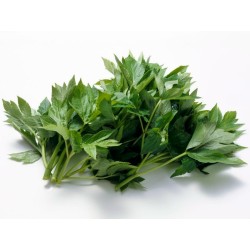
Ashitaba seeds (Tomorrow's...
Prijs
€ 3,95
(SKU: MHS 100)
Seeds Gallery EU,
5/
5
<h2><strong>Ashitaba seeds (Tomorrow's Leaf) (Angelica keiskei)</strong></h2>
<h2><span style="color: #ff0000;"><strong>Price for Package of 5 seeds.</strong></span></h2>
<p><span>Angelica keiskei Koidzumi, commonly known under the Japanese name of Ashitaba (アシタバ or 明日葉 ashitaba, literally "Tomorrow's Leaf"), is a cold hardy perennial plant from the angelica genus with an average growth height of 50–120 cm. It is endemic to Hachijō-jima, though it is artificially cultivated in Izu Ōshima, Mikura-jima, Nii-jima, To-shima and parts of Honshū as well.</span></p>
<p><span>The plant's additional cultivar epithet koidzumi refers to botanist Gen'ichi Koizumi, while its Japanese nomenclature stems from the above-average regenerative capabilities it exhibits after injury. Harvesting a leaf at the break of day often results in a new sprout growing overnight, being visible the following morning.</span></p>
<p><span>Traditionally it is seen as a major contributor to the supposedly healthier, extended lives of the local residents, possibly due to the chalconoids that are unique to this species of angelica. At one point in Edo period, the haulm's yellow sap was effectively used in the external treatment of smallpox, which prompted Kaibara Ekken to describe the herb in his Yamato honzō (大和本草), under the name of ashitagusa (鹹草), as "a powerful tonic drug." In folk medicine it is claimed to be diuretic, tonic, to improve digestion, and, when applied topically, to speed wound healing and prevent infection. Also, its nutritive qualities are said to be the factor behind the internal exiles' and their families' never waning stamina in the face of their arduous compulsory labor.</span></p>
<p><span>For similar reasons, it very widely serves as pasture for cows, reckoned to improve the quality of milk as well as the yield and to maintain cattle health at the same time. It should be pointed out that most of these claims have yet to be proven in clinical trials, while studies have substantiated the presence of furocoumarins in several of these plants' components. Furanocumarin is an agent known to increase skin sensitivity to sunlight and may cause dermatitis.</span></p>
<p><span>Nonetheless, modest conditions for cultivation and fast rate of growth, with optimal temperatures ranging between 12-22 degrees, have led many locals to plant ashitaba in herb gardens, flower pots, and backyards. These days the main use of their stipes, leaves, and taproots is in regional cuisine, where they are prepared as soba, tempura, shōchū, tea, ice cream, pasta etc. The Mikura-jima variety might excel in this regard as it is reputed to be less bitter than others.</span></p>
<p><span>Note that ashitaba closely resembles Angelica japonica, but can be distinguished by its blooming period, which lasts from May to October whereas A. japonica's blooming period lasts only between May and July. Another indicator is the characteristic color of its sap.[2] The larvae of the Common Yellow Swallowtail are known to feed frequently on the plant.</span></p>
<h2><span>Medicinal properties</span></h2>
<p><span>A. keiskei has been claimed to exhibit cytotoxic, antidiabetic, antioxidative, anti-inflammatory, antihypertensive, and antimicrobial properties via in vitro studies, but the efficacy of these qualities have yet to be confirmed in vivo.[3] Among current investigations is its potential as a nerve growth factor,[4] as well as potential usefulness in cancer, menopause, and other conditions.[5] Ashitaba may have positive effects on circulation by preventing red blood cells from clumping.</span></p>
<h2><strong><span>Claims of being a vegetable source of vitamin B12</span></strong></h2>
<p><span>Although it is often suggested that A. keiskei is a vegetable source of vitamin B12 (cyanocobalamin), recently published, peer-reviewed scientific investigations of pharmacology and phytochemical constituents of interest report nothing that substantiates this claim.[7][8] Traditional methods for measuring vitamin B12 in foods are compromised by contaminants (e.g. soil, bacteria, etc.) that contain detectable concentrations of inactive B12 analogs, which may explain the origin of this belief.[9] More recent studies reveal certain mushrooms and algae as the only naturally occurring sources of B12 outside of the animal kingdom.[10] Of these, only Chlorella has demonstrated the ability to reduce methyl malonic acid (MMA) levels (a product of B12 deficiency) in human subjects.</span></p>
<p><strong><span>Soak seeds overnight in cool, non-chlorinated water and then refrigerate the seeds (approximately 40 degrees F) in the moist medium for 3 days. </span></strong></p>
<p><strong><span>The moist medium could be moist sand, moist potting soil, moist coir or moist peat. </span></strong></p>
<p><strong><span>Note that our recommendation is MOIST, not SODDEN or VERY WET and that we are recommending REFRIGERATION not FREEZING. </span></strong></p>
<p><strong><span>After this pretreatment, plant the (still moist) seeds. </span></strong></p>
<p><strong><span>Sow on surface, barely cover with soil and press in firmly and keep evenly moist until germination. </span></strong></p>
<p><strong><span>Use a greenhouse, shade house or grow lights. </span></strong></p>
<p><strong><span>Germination Temperature is around 20C/68F</span></strong></p>
<p><strong><span>Germination occurs 30 to 60 days after sowing. </span></strong></p>
<p><strong><span>Seedlings are slow-growing and will require about 60 days to transplant. </span></strong></p>
<p><strong><span>Once past the seedling stage, the plant is fast growing. </span></strong></p>
<p><strong><span>The plants prefer rich, deep, ever moist, well-drained soil and full sun to part shade. </span></strong></p>
<p><strong>Water every other day.</strong></p>
MHS 100 (5 S)


Variëteit uit Servië
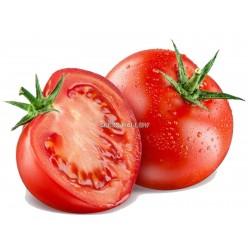
5000 Seeds Novosadski...
Prijs
€ 22,00
(SKU: VT 130 (25g))
Seeds Gallery EU,
5/
5
<h2 class="">5000 Seeds Novosadski Jabucar Tomato</h2>
<h2><span style="color: #ff0000; font-size: 14pt;"><strong>Price for Package of 5000 seeds (25g).</strong></span></h2>
<div>70-80 days, Medium early variety, Indeterminate. The fruits are round, smooth, bright red, average weight is 130-150 g. He has a good ratio of total sugar and acid, with a dry matter content of 6 to 6.5% and a very good taste. It can be grown from seeds, and without support.</div>
<div>History:</div>
<div>Old tested variety from Serbia. 'Jabucar' means 'Apple' in Serbian.</div><script src="//cdn.public.n1ed.com/G3OMDFLT/widgets.js"></script>
VT 130 (25g)


Variëteit uit Servië
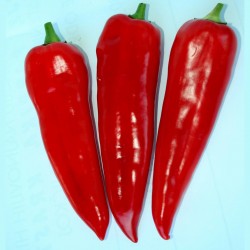
Kurtovska Kapija Sweet...
Prijs
€ 1,95
(SKU: PP 39)
Seeds Gallery EU,
5/
5
<h2 class=""><strong>Kurtovska Kapija Sweet Pepper Seeds (Kurt's Gate)</strong></h2>
<h2><span style="color: #ff0000;" class=""><strong>Price for Package of 50 seeds.</strong></span></h2>
<div>The Kurtovska kapija sweet pepper (Kurt's Gate) is a favorite variety in Serbia when it comes to winter food preservation, especially for making <span style="color: #ff0000;"><a href="https://en.wikipedia.org/wiki/Ajvar" target="_blank" title=""Ajvar"" style="color: #ff0000;" rel="noreferrer noopener"><strong>"Ajvar"</strong></a></span>. The fruit is sweet, weighs 150 to 300 grams, large, thick pericarp in the technologically mature dark green, and in biologically intense red. </div>
<div></div>
<div>The Plant: strong, compact, tall, hanging fruits. </div>
<div>Kurt's Gate Pepper is a late variety.</div>
<div></div>
<div>Yields range up to 30 t / ha</div>
<script src="//cdn.public.n1ed.com/G3OMDFLT/widgets.js"></script>
PP 39 (50 S)


Variëteit uit Servië
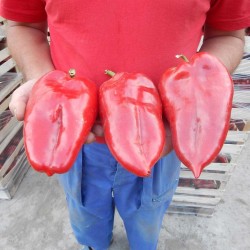
Olifantenoor paprika zaden
Prijs
€ 2,15
(SKU: PP 56)
Seeds Gallery EU,
5/
5
<h2><strong>Olifantenoor paprika zaden</strong></h2>
<h2><span style="color: #ff0000;" class=""><strong>Prijs is voor een verpakking van 50 zaden.</strong></span></h2>
<p>Groot fruitig, aromatisch. Olifantenoor is een van de favoriete Servische variëteiten in Servië, het wordt meestal gebruikt voor het maken van "ajvar", "pinđur", vulling en om in te vriezen. Ze kunnen goed worden gebruikt voor het beitsen, om te grillen, in groentegerechten, in vleesgerechten en als salade.</p>
<p>Uitstekend van smaak.</p>
<p>Elephant's Ear is paprika, met zeer grote en vlezige vruchten. De kleur van de vrucht verandert van donkergroen naar felrood als hij rijp is. Bereikt een gewicht van 150-350gr. Het is zeer ziekteresistent en levert een stabiele opbrengst van 50/60 ton per hectare. Dit ras is geschikt voor in de kas, voor koude kozijnen, maar ook voor buiten.</p>
<script src="//cdn.public.n1ed.com/G3OMDFLT/widgets.js"></script>
PP 56 (50 S)


Variëteit uit Servië
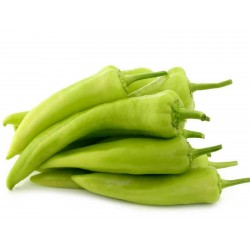
Sweet Pepper Seeds ECSTASY
Prijs
€ 2,45
(SKU: PP 57)
Seeds Gallery EU,
5/
5
<h2><strong>Sweet Pepper Seeds ECSTASY</strong></h2>
<h2><span style="color: #ff0000;"><strong>Price for Package of 20 seeds.</strong></span></h2>
<p>ECSTASY is a very early variety from Serbia with long fruits intended for cultivation in greenhouses and in the open field. The fruits reach a length of 25-30 cm. The fruits are sweet and delicious. In the greenhouse, the plants grow up to 170 cm in height.</p>
<p><strong>Fruit Weight:</strong> 130 g</p>
<p><strong>Fruit length:</strong> 25-30 cm.</p>
<p><strong>Serbian Variety</strong></p>
PP 57 (20 S)


Variëteit uit Servië
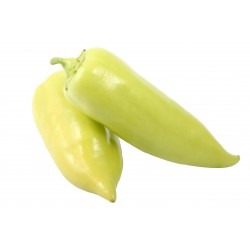
Sweet pepper seeds ROMANCE...
Prijs
€ 1,95
(SKU: PP 34)
Seeds Gallery EU,
5/
5
<h2><strong>Sweet pepper seeds ROMANCE - Variety from Serbia</strong></h2>
<h2><span style="color: #ff0000;"><strong>Price is for pack of 20 seeds.</strong></span></h2>
<p>Romance is an early variety from Serbia, long, large and meaty, for cultivation in a protected area and open field. Young fruits are light green to yellow and ripe red. They are conical, sweet, reaching a length of 25-30 cm, a width of 6-7 cm and weighing 250 g per fruit.</p>
<p>Romance has an excellent sweet aroma.</p>
PP 34 (20 S)


Variëteit uit Servië
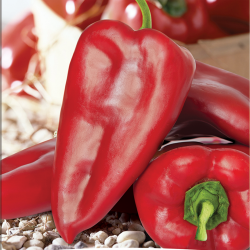
Grote paprika Supernova zaden
Prijs
€ 1,75
(SKU: PP 61)
Seeds Gallery EU,
5/
5
<h2><strong>Grote paprika Supernova zaden</strong></h2>
<h2><span style="color: #ff0000;"><strong>Prijs voor een pakket van 50 zaden.</strong></span></h2>
<p>Supernova-paprika's hebben grote vruchten die tijdens het rijpen van groen naar rood verkleuren. De vruchten zijn groot, met een gewicht tot 300 gram, erg zoet.</p>
<p>Dit ras is uitstekend geschikt gebleken voor zowel bakken als winterstalling. Het is geschikt om in te vriezen en later te gebruiken.</p>
<p>Wat betreft de teelt zelf, deze heeft laten zien dat het zowel in de volle grond als in de kas slaagt.</p>
<p>De plant is sterk en bestand tegen veel ziekten die paprika's aantasten.</p>
PP 61 (50 S)


Variëteit uit Servië
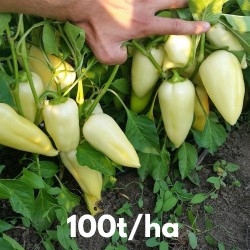
Amanda paprika zaden
Prijs
€ 2,15
(SKU: PP 62)
Seeds Gallery EU,
5/
5
<h2><strong>Amanda paprika zaden</strong></h2>
<h2><span style="color: #ff0000;"><strong>Prijs voor een pakket van 50 zaden.</strong></span></h2>
<p>Amanda is een variëteit met dik vruchtvlees en een spitse punt. Hij behoort tot de variëteit witte peper en is uitstekend geschikt voor zowel de kaskweek als buiten, maar de opbrengst in de kas kan wel twee keer zo hoog zijn.</p>
<p>De plant is compact, sterk, met grote bladeren. De vrucht heeft dik, knapperig en zeer sappig vruchtvlees, het is een van de paprika's. De vruchten hangen aan de plant en wegen 120 tot 160 gram. Het is geweldig voor augurken en frituren, evenals voor verse consumptie.</p>
<p>Het ras is zeer productief en heeft een zeer mooie vorm, in de kas kan hij bij goede verzorging en voeding tot 2 kg per plant geven. De vrucht is eerst wit en wordt dan geleidelijk geel en rood. Zaden van deze variëteit kunnen worden verwijderd en jarenlang voor reproductie worden bewaard.</p>
<p>Het is geschikt voor vroege productie en verse consumptie.</p>
PP 62 (50 S)

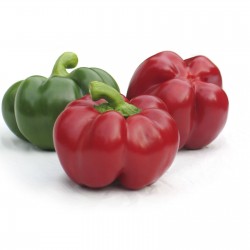
Paprikazaden - Groene Rotund
Prijs
€ 1,85
(SKU: PP 67)
Seeds Gallery EU,
5/
5
<div id="idTab1" class="rte">
<h2><strong>Paprikazaden - Groene Rotund</strong></h2>
<h2><span style="color: #ff0000;"><strong>Prijs voor een pakket van 20 zaden.</strong></span></h2>
<p>Mooie paprika uit Bulgarije. Rotund is geweldig voor vers eten in salades, beitsen en koken. Het kan worden gedroogd en gebruikt als paprikapoeder. Deze prachtige erfgoedpeper is van groot belang in de tuin.</p>
<p>Het ras rijpt vroeg. Van volledige ontkieming van planten tot technische rijpheid van fruit is 108-120 dagen tot biologisch - 140-155 dagen. Het is een middelgrote, halfstammige, compacte plant van 40-60 cm hoog. De ronde vruchten zijn glad, met een gemiddeld gewicht van 150-220 g. In industriële rijpheid zijn de vruchten groen, in biologische rijpheid zijn ze donkerrood. De wanddikte van zacht vlees is ongeveer 8-9 mm.</p>
<p>Bij biologische rijpheid bevatten vruchten 7,0-8,2% droge base, 4,2-4,6% sucrose, 145-198 mg% ascorbinezuur.</p>
<p>Het wordt gekenmerkt door een hoge voedselkwaliteit en verkoopbaarheid. Het is resistent tegen vele ziekten. Opbrengst is 40-60 t/ha.</p>
<p>Herkomst: Bulgarije</p>
</div>
PP 67 (20 S)


Plant bestand tegen kou en vorst
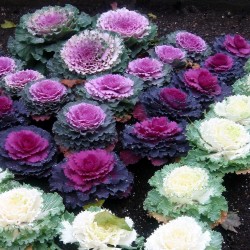
Flowering Kale Seeds...
Prijs
€ 1,95
(SKU: VE 92)
Seeds Gallery EU,
5/
5
<meta http-equiv="Content-Type" content="text/html; charset=UTF-8" />
<h2><strong>Flowering Kale Seeds Brassica Oleracea</strong></h2>
<h2><span style="color: #ff0000;"><strong>Price for a Package of 25 seeds.</strong></span></h2>
<div>Plant grown for autumn and winter interest. <span style="font-size: 11px; line-height: 1.5em;">Rosettes of cabbage like leaves in white-green, pink, red, and violet-purple. </span><span style="font-size: 11px; line-height: 1.5em;">The colour intensifies as the temperature drops. </span><span style="font-size: 11px; line-height: 1.5em;">Used in containers and for table decoration but also finds use as a winter bedding plant.</span></div>
<div><em><strong>SOWING INSTRUCTIONS</strong></em></div>
<div>Optimum Germination Temp: 15°C</div>
<div>Sowing Depth: 1cm </div>
<div>Sow indoors: March-May</div>
<div>Transplant to Garden: May</div>
<div>Plant spacing: 30cm</div>
<div>Full sun preferred</div>
<div>Flowers: July - November</div>
<div>Mixed Colours</div>
VE 92 (25 S)


Variëteit uit Griekenland

Basil Greek Bascuro seeds...
Prijs
€ 1,45
(SKU: MHS 97)
Seeds Gallery EU,
5/
5
<h2><strong>Basil Greek Bascuro seeds (Ocimum minimum)</strong></h2>
<h2><span style="color: #ff0000;"><strong>Price for Package of 50 Seeds.</strong></span></h2>
<p>A great basil that has a tiny hummock of a plant, resembling a Lilliputian Oak tree, but redolent with the finest of Basil aroma. Does well in pots, and fits well in pots, even small ones. This type has a bushy habit. The leaves are quite small but the aroma and the flavor are quite large. Very slow to bolt, which is an advantage for home growers but makes it challenging for us to produce seedcrops–we start mighty early! We vote this the best-tasting Basil of all. Traditionally in Greece, a sprig is placed behind the ear to mask unpleasant smells (like tobacco smoke) and attract women (or men).</p>
<p>Easy to grow. Annual.</p>
<p>Family: Mint (Lamiaceae)</p>
<p>Annual, with first harvest at 70 days.</p>
MHS 97 (50 S)


Variëteit uit Italië
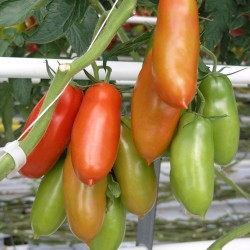
San Marzano Gigante (Gran...
Prijs
€ 2,85
(SKU: VT 166)
Seeds Gallery EU,
5/
5
<h2><strong>San Marzano Gigante (Gran Merito) Tomatenzaden</strong></h2>
<h2><span style="color: #ff0000;"><strong>Prijs voor een pakket van 10 zaden.</strong></span></h2>
<p>De Italiaanse tomaat San Marzano Gigante, ook wel bekend als "Gran Merito". De mooie ovale vruchten groeien in trossen van 6 tot 10 vruchten en wegen gemiddeld 90 tot 120g. Ze rijpen tot een rode kleur in een periode van ongeveer 65 tot 75 dagen na het zaaien.</p>
<p>Deze sappige, heerlijke tomaten zijn lang houdbaar en worden zowel in salades en koude gerechten als in sauzen en gekookte gerechten gebruikt.</p>
<p>De sterke planten worden gemiddeld 90 tot 100 cm hoog en hebben een uitstekende opbrengst. (Bepaal de groei)</p>
<p>De tomaat San Marzano Gigante is niet hybride, is vrij van chemische behandeling, niet-GMO en vrij van gif.</p>
VT 166 (10 S)


Verscheidenheid uit India
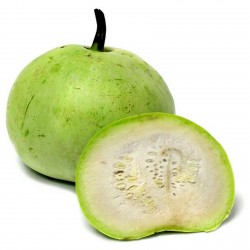
Tinda Seeds, Apple Gourd...
Prijs
€ 3,00
(SKU: VE 93)
Seeds Gallery EU,
5/
5
<h2><strong>Tinda Seeds, Apple Gourd (Praecitrullus fistulosus)</strong></h2>
<h2><span style="color: #ff0000;"><strong>Price for Package of 3 seeds.</strong></span></h2>
<p>Tinda also called "Indian squash", "round melon", "Indian round gourd" or "apple gourd" or "Indian baby pumpkin", is a squash-like cucurbit grown for its immature fruit, a vegetable especially popular in South Asia.</p>
<p><strong>Distribution and use</strong></p>
<p>The species is native to India and Pakistan and is cultivated in the north of both countries, where the ripe fruits are a popular vegetable. The harvest takes place before the seed husks harden. The fruits are cooked after removing the seeds, often together with lentils. They are also inserted. The seeds are eaten roasted. There are two different forms: one with light green fruits, which is generally preferred, and the other with dark green fruits.</p>
<p>The plant is as with all cucurbits, a prolific vine, and is grown as an annual. The plant also is prickly with small thorns similar to the zucchini. The fruit is approximately spherical, and 5–8 cm in diameter The seeds may also be roasted and eaten. Tinda is a famous nickname among Punjabi families in India. This unique squash-like gourd is native to South Asia, very popular in Indian and Pakistani cooking with curry and many gourmet dishes. Green colored, apple-sized fruits are flattish round in shape and 50–60 grams in weight. Plants are vigorous, productive and begin to bear fruits in 70 days after planting.</p>
<p>Tinda can be confused with tendli or kundru due to similar-sounding names from different languages and regions. Tinda in Punjabi or most North Indian languages are "Indian baby pumpkin".</p>
<p>Tinda is considered a boring vegetable by many in North India – part of the reason is it is used in a lot of curries during high season and tastes bland unless used with a lot of spices. Further, its seeds are not favored by many. It is practically unknown in South India.</p>
VE 93 (3 S)


Variëteit uit Servië

Plant bestand tegen kou en vorst
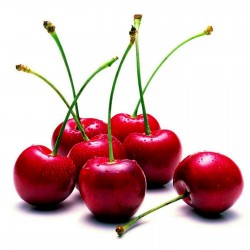
Serbian sweet dwarf Morello...
Prijs
€ 1,95
(SKU: V 216)
Seeds Gallery EU,
5/
5
<h2><strong>Serbian morello cherry seeds (Prunus cerasus)</strong></h2>
<h2 class=""><span style="color: #ff0000;"><strong>Price for Package of 10 (2,5g) seeds.</strong></span></h2>
<p>This cherry variety originally comes from Serbia and is over 120 years old. The fruits are extremely large (almost as big as cherries), dark-red in color, and very sweet. The tree reaches a height of approx. 4 meters and a diameter of approx. 2 to 3 meters. The variety is extremely fertile and can deliver over 50 kilograms of cherries in season.</p>
<p>This variety withstood temperatures of - 30 degrees Celsius. However, it is believed that it can easily withstand -40 an more degrees Celsius. It is resistant to diseases and there is no need to use chemical preparations.</p>
<h3><strong>You can read more about cherries on Wikipedia:</strong></h3>
<p><i><b>Prunus cerasus</b></i><span> </span>(<b>sour<span> </span>cherry</b>,<sup id="cite_ref-3" class="reference">[3]</sup><span> </span><b>tart cherry</b>, or<span> </span><b>dwarf cherry</b><sup id="cite_ref-BSBI07_4-0" class="reference">[4]</sup>) is a species of<span> </span><i>Prunus</i><span> </span>in the subgenus<span> </span><i>Cerasus</i><span> </span>(cherries), native to much of<span> </span>Europe<span> </span>and southwest<span> </span>Asia. It is closely related to the sweet cherry (<i>Prunus avium</i>), but has a<span> </span>fruit<span> </span>that is more<span> </span>acidic. Its sour pulp is edible.<sup id="cite_ref-5" class="reference">[5]</sup></p>
<p>The tree is smaller than the sweet cherry (growing to a height of 4–10 m), has twiggy branches, and its crimson-to-near-black cherries are borne upon shorter stalks.<sup class="noprint Inline-Template Template-Fact">[<i><span title="This claim needs references to reliable sources. (December 2013)">citation needed</span></i>]</sup><span> </span>There are two main varieties (groups of<span> </span>cultivars) of the<span> </span><b>sour cherry</b>: the dark-red<span> </span><b>morello cherry</b><span> </span>and the lighter-red<span> </span><b>amarelle cherry</b>.</p>
<h2><span class="mw-headline" id="Origins_and_cultivation">Origins and cultivation</span></h2>
<div class="thumb tright">
<div class="thumbinner"><img alt="Serbian morello cherry seeds (Prunus cerasus)" src="https://upload.wikimedia.org/wikipedia/commons/thumb/e/e4/Illustration_Prunus_cerasus0.jpg/220px-Illustration_Prunus_cerasus0.jpg" decoding="async" width="220" height="359" class="thumbimage" srcset="//upload.wikimedia.org/wikipedia/commons/thumb/e/e4/Illustration_Prunus_cerasus0.jpg/330px-Illustration_Prunus_cerasus0.jpg 1.5x, //upload.wikimedia.org/wikipedia/commons/thumb/e/e4/Illustration_Prunus_cerasus0.jpg/440px-Illustration_Prunus_cerasus0.jpg 2x" data-file-width="1462" data-file-height="2388" title="Serbian morello cherry seeds (Prunus cerasus)" />
<div class="thumbcaption">
<div class="magnify"></div>
Illustration of Morello Cherry</div>
</div>
</div>
<p><i>Prunus cerasus</i>, a<span> </span>tetraploid<span> </span>with 2n=32 chromosomes, is thought to have originated as a natural hybrid between<span> </span><i>Prunus avium</i><span> </span>and<span> </span><i>Prunus fruticosa</i><span> </span>in the<span> </span>Iranian Plateau<span> </span>or Eastern Europe where the two species come into contact.<span> </span><i>Prunus fruticosa</i><span> </span>is believed to have provided its smaller size and sour tasting fruit. The hybrids then stabilised and interbred to form a new, distinct species.<sup id="cite_ref-7" class="reference">[7]</sup></p>
<p>Cultivated sour cherries were selected from wild specimens of<span> </span><i>Prunus cerasus</i><span> </span>and the doubtfully distinct<span> </span><i>P. acida</i><span> </span>from around the<span> </span>Caspian<span> </span>and<span> </span>Black Seas, and were known to the<span> </span>Greeks<span> </span>in 300 BC. They were also extremely popular with<span> </span>Persians<span> </span>and the<span> </span>Romans<span> </span>who introduced them into<span> </span>Britain<span> </span>long before the 1st century AD. The fruit remains popular in modern-day<span> </span>Iran.</p>
<p>In England, their cultivation was popularised in the 16th century in the time of<span> </span>Henry VIII. They became a popular crop amongst Kentish growers, and by 1640 over two dozen named<span> </span>cultivars<span> </span>were recorded. In the Americas, by 1704 the Vestry of<span> </span>New Kent County, Virginia<span> </span>recorded "The DePriest of Kent" planted 354 acres of Prunus cerasus along the<span> </span>Pamunkey River<span> </span>as the 'Kent' variety, that spawned other<span> </span>Virginia<span> </span>colonists throughout Richmond to plant sour cherry trees, 'Early Richmond' variety or 'Kentish Red', when they arrived.<sup id="cite_ref-8" class="reference">[8]</sup></p>
<div class="thumb tright">
<div class="thumbinner"><img alt="Serbian morello cherry seeds (Prunus cerasus)" src="https://upload.wikimedia.org/wikipedia/commons/thumb/5/57/Fr%C3%BChling_bl%C3%BChender_Kirschenbaum.jpg/220px-Fr%C3%BChling_bl%C3%BChender_Kirschenbaum.jpg" decoding="async" width="220" height="166" class="thumbimage" srcset="//upload.wikimedia.org/wikipedia/commons/thumb/5/57/Fr%C3%BChling_bl%C3%BChender_Kirschenbaum.jpg/330px-Fr%C3%BChling_bl%C3%BChender_Kirschenbaum.jpg 1.5x, //upload.wikimedia.org/wikipedia/commons/thumb/5/57/Fr%C3%BChling_bl%C3%BChender_Kirschenbaum.jpg/440px-Fr%C3%BChling_bl%C3%BChender_Kirschenbaum.jpg 2x" data-file-width="2272" data-file-height="1712" title="Serbian morello cherry seeds (Prunus cerasus)" />
<div class="thumbcaption">
<div class="magnify"></div>
A blooming sour cherry tree</div>
</div>
</div>
<p>Before the<span> </span>Second World War<span> </span>there were more than fifty cultivars of sour cherry in cultivation in England; today, however, few are grown commercially, and despite the continuation of named cultivars such as 'Kentish Red', 'Amarelles', 'Griottes' and 'Flemish', only the generic Morello is offered by most nurseries. This is a late-flowering variety, and thus misses more frosts than its sweet counterpart and is therefore a more reliable cropper. The Morello cherry ripens in mid to late summer, toward the end of August in southern England. It is self-fertile, and would be a good<span> </span>pollenizer<span> </span>for other varieties if it did not flower so late in the season.</p>
<div class="thumb tright">
<div class="thumbinner"><img alt="Serbian morello cherry seeds (Prunus cerasus)" src="https://upload.wikimedia.org/wikipedia/commons/thumb/b/bc/SourcherryYield.png/220px-SourcherryYield.png" decoding="async" width="220" height="132" class="thumbimage" srcset="//upload.wikimedia.org/wikipedia/commons/thumb/b/bc/SourcherryYield.png/330px-SourcherryYield.png 1.5x, //upload.wikimedia.org/wikipedia/commons/thumb/b/bc/SourcherryYield.png/440px-SourcherryYield.png 2x" data-file-width="1600" data-file-height="960" title="Serbian morello cherry seeds (Prunus cerasus)" />
<div class="thumbcaption">
<div class="magnify"></div>
Worldwide sour cherry production</div>
</div>
</div>
<p>Sour cherries require similar cultivation conditions to<span> </span>pears, that is, they prefer a rich, well-drained, moist<span> </span>soil, although they demand more<span> </span>nitrogen<span> </span>and<span> </span>water<span> </span>than sweet cherries. Trees will do badly if waterlogged, but have greater tolerance of poor drainage than sweet varieties. As with sweet cherries, Morellos are traditionally cultivated by budding onto strong growing rootstocks, which produce trees too large for most gardens, although newer dwarfing rootstocks such as<span> </span><i>Colt</i><span> </span>and<span> </span><i>Gisella</i><span> </span>are now available. During spring, flowers should be protected, and trees weeded, mulched and sprayed with natural seaweed solution. This is also the time when any required<span> </span>pruning<span> </span>should be carried out (note that cherries should not be pruned during the dormant winter months). Morello cherry trees fruit on younger wood than sweet varieties, and thus can be pruned harder. They are usually grown as standards, but can be fan trained, cropping well even on cold walls, or grown as low bushes.<sup id="cite_ref-9" class="reference">[9]</sup></p>
<div class="thumb tright">
<div class="thumbinner"><img alt="Serbian morello cherry seeds (Prunus cerasus)" src="https://upload.wikimedia.org/wikipedia/commons/thumb/9/9f/Ripe_sour_cherries_on_a_branch.jpg/220px-Ripe_sour_cherries_on_a_branch.jpg" decoding="async" width="220" height="161" class="thumbimage" srcset="//upload.wikimedia.org/wikipedia/commons/thumb/9/9f/Ripe_sour_cherries_on_a_branch.jpg/330px-Ripe_sour_cherries_on_a_branch.jpg 1.5x, //upload.wikimedia.org/wikipedia/commons/9/9f/Ripe_sour_cherries_on_a_branch.jpg 2x" data-file-width="430" data-file-height="314" title="Serbian morello cherry seeds (Prunus cerasus)" />
<div class="thumbcaption">
<div class="magnify"></div>
Ripe sour cherries (Somogy,<span> </span>Hungary)</div>
</div>
</div>
<div class="thumb tright">
<div class="thumbinner"><img alt="Serbian morello cherry seeds (Prunus cerasus)" src="https://upload.wikimedia.org/wikipedia/commons/thumb/9/94/Black_Che.jpg/220px-Black_Che.jpg" decoding="async" width="220" height="163" class="thumbimage" srcset="//upload.wikimedia.org/wikipedia/commons/thumb/9/94/Black_Che.jpg/330px-Black_Che.jpg 1.5x, //upload.wikimedia.org/wikipedia/commons/thumb/9/94/Black_Che.jpg/440px-Black_Che.jpg 2x" data-file-width="2944" data-file-height="2184" title="Serbian morello cherry seeds (Prunus cerasus)" />
<div class="thumbcaption">
<div class="magnify"></div>
Ripe sour cherries and their leaves (Karaj,<span> </span>Iran)</div>
</div>
</div>
<div class="thumb tright">
<div class="thumbinner"><img alt="Serbian morello cherry seeds (Prunus cerasus)" src="https://upload.wikimedia.org/wikipedia/commons/thumb/a/a6/Owoce_Wi%C5%9Bnia.jpg/220px-Owoce_Wi%C5%9Bnia.jpg" decoding="async" width="220" height="220" class="thumbimage" srcset="//upload.wikimedia.org/wikipedia/commons/thumb/a/a6/Owoce_Wi%C5%9Bnia.jpg/330px-Owoce_Wi%C5%9Bnia.jpg 1.5x, //upload.wikimedia.org/wikipedia/commons/thumb/a/a6/Owoce_Wi%C5%9Bnia.jpg/440px-Owoce_Wi%C5%9Bnia.jpg 2x" data-file-width="1024" data-file-height="1024" title="Serbian morello cherry seeds (Prunus cerasus)" />
<div class="thumbcaption">
<div class="magnify"></div>
A sour cherry Beauty Sheet</div>
</div>
</div>
<p>Sour cherries suffer fewer pests and diseases than sweet cherries, although they are prone to heavy fruit losses from<span> </span>birds. In summer, fruit should be protected with netting. When harvesting fruit, they should be cut from the tree rather than risking damage by pulling the stalks.</p>
<p>Unlike most sweet cherry varieties, sour cherries are<span> </span>self fertile<span> </span>or self<span> </span>pollenizing<span> </span>(sometimes inaccurately referred to as<span> </span>self-pollinating). Two implications of this are that seeds generally run true to the cultivar, and that much smaller<span> </span>pollinator<span> </span>populations are needed because<span> </span>pollen<span> </span>only has to be moved within individual flowers. In areas where pollinators are scarce, growers find that<span> </span>stocking beehives<span> </span>in orchards improves yields.<sup id="cite_ref-10" class="reference">[10]</sup></p>
<p>Some cultivars of sour cherry trees, such as Montmorency and<span> </span>North Star, have been documented to perform better than other cherry trees in Colorado's<span> </span>Front Range<span> </span>region.<sup id="cite_ref-11" class="reference">[11]</sup><sup id="cite_ref-12" class="reference">[12]</sup></p>
<table class="wikitable">
<tbody>
<tr>
<th colspan="5">Top 10 sour cherry producers in 2012</th>
</tr>
<tr>
<th>Country</th>
<th>Production (tonnes)</th>
<th>Footnote</th>
</tr>
<tr>
<td align="left"><span class="flagicon"><img alt="" src="https://upload.wikimedia.org/wikipedia/commons/thumb/b/b4/Flag_of_Turkey.svg/23px-Flag_of_Turkey.svg.png" decoding="async" width="23" height="15" class="thumbborder" srcset="//upload.wikimedia.org/wikipedia/commons/thumb/b/b4/Flag_of_Turkey.svg/35px-Flag_of_Turkey.svg.png 1.5x, //upload.wikimedia.org/wikipedia/commons/thumb/b/b4/Flag_of_Turkey.svg/45px-Flag_of_Turkey.svg.png 2x" data-file-width="1200" data-file-height="800" /> </span>Turkey</td>
<td>187,941</td>
<td></td>
</tr>
<tr>
<td align="left"><span class="flagicon"><img alt="" src="https://upload.wikimedia.org/wikipedia/en/thumb/f/f3/Flag_of_Russia.svg/23px-Flag_of_Russia.svg.png" decoding="async" width="23" height="15" class="thumbborder" srcset="//upload.wikimedia.org/wikipedia/en/thumb/f/f3/Flag_of_Russia.svg/35px-Flag_of_Russia.svg.png 1.5x, //upload.wikimedia.org/wikipedia/en/thumb/f/f3/Flag_of_Russia.svg/45px-Flag_of_Russia.svg.png 2x" data-file-width="900" data-file-height="600" /> </span>Russia</td>
<td>183,300</td>
<td>*</td>
</tr>
<tr>
<td align="left"><span class="flagicon"><img alt="" src="https://upload.wikimedia.org/wikipedia/en/thumb/1/12/Flag_of_Poland.svg/23px-Flag_of_Poland.svg.png" decoding="async" width="23" height="14" class="thumbborder" srcset="//upload.wikimedia.org/wikipedia/en/thumb/1/12/Flag_of_Poland.svg/35px-Flag_of_Poland.svg.png 1.5x, //upload.wikimedia.org/wikipedia/en/thumb/1/12/Flag_of_Poland.svg/46px-Flag_of_Poland.svg.png 2x" data-file-width="1280" data-file-height="800" /> </span>Poland</td>
<td>175,391</td>
<td></td>
</tr>
<tr>
<td align="left"><span class="flagicon"><img alt="" src="https://upload.wikimedia.org/wikipedia/commons/thumb/4/49/Flag_of_Ukraine.svg/23px-Flag_of_Ukraine.svg.png" decoding="async" width="23" height="15" class="thumbborder" srcset="//upload.wikimedia.org/wikipedia/commons/thumb/4/49/Flag_of_Ukraine.svg/35px-Flag_of_Ukraine.svg.png 1.5x, //upload.wikimedia.org/wikipedia/commons/thumb/4/49/Flag_of_Ukraine.svg/45px-Flag_of_Ukraine.svg.png 2x" data-file-width="1200" data-file-height="800" /> </span>Ukraine</td>
<td>172,800</td>
<td></td>
</tr>
<tr>
<td align="left"><span class="flagicon"><img alt="" src="https://upload.wikimedia.org/wikipedia/commons/thumb/c/ca/Flag_of_Iran.svg/23px-Flag_of_Iran.svg.png" decoding="async" width="23" height="13" class="thumbborder" srcset="//upload.wikimedia.org/wikipedia/commons/thumb/c/ca/Flag_of_Iran.svg/35px-Flag_of_Iran.svg.png 1.5x, //upload.wikimedia.org/wikipedia/commons/thumb/c/ca/Flag_of_Iran.svg/46px-Flag_of_Iran.svg.png 2x" data-file-width="630" data-file-height="360" /> </span>Iran</td>
<td>105,000</td>
<td>F</td>
</tr>
<tr>
<td align="left"><span class="flagicon"><img alt="" src="https://upload.wikimedia.org/wikipedia/commons/thumb/f/ff/Flag_of_Serbia.svg/23px-Flag_of_Serbia.svg.png" decoding="async" width="23" height="15" class="thumbborder" srcset="//upload.wikimedia.org/wikipedia/commons/thumb/f/ff/Flag_of_Serbia.svg/35px-Flag_of_Serbia.svg.png 1.5x, //upload.wikimedia.org/wikipedia/commons/thumb/f/ff/Flag_of_Serbia.svg/45px-Flag_of_Serbia.svg.png 2x" data-file-width="945" data-file-height="630" /> </span>Serbia</td>
<td>74,656</td>
<td></td>
</tr>
<tr>
<td align="left"><span class="flagicon"><img alt="" src="https://upload.wikimedia.org/wikipedia/commons/thumb/c/c1/Flag_of_Hungary.svg/23px-Flag_of_Hungary.svg.png" decoding="async" width="23" height="12" class="thumbborder" srcset="//upload.wikimedia.org/wikipedia/commons/thumb/c/c1/Flag_of_Hungary.svg/35px-Flag_of_Hungary.svg.png 1.5x, //upload.wikimedia.org/wikipedia/commons/thumb/c/c1/Flag_of_Hungary.svg/46px-Flag_of_Hungary.svg.png 2x" data-file-width="1200" data-file-height="600" /> </span>Hungary</td>
<td>53,425</td>
<td></td>
</tr>
<tr>
<td align="left"><span class="flagicon"><img alt="" src="https://upload.wikimedia.org/wikipedia/en/thumb/a/a4/Flag_of_the_United_States.svg/23px-Flag_of_the_United_States.svg.png" decoding="async" width="23" height="12" class="thumbborder" srcset="//upload.wikimedia.org/wikipedia/en/thumb/a/a4/Flag_of_the_United_States.svg/35px-Flag_of_the_United_States.svg.png 1.5x, //upload.wikimedia.org/wikipedia/en/thumb/a/a4/Flag_of_the_United_States.svg/46px-Flag_of_the_United_States.svg.png 2x" data-file-width="1235" data-file-height="650" /> </span>United States</td>
<td>38,601</td>
<td></td>
</tr>
<tr>
<td align="left"><span class="flagicon"><img alt="" src="https://upload.wikimedia.org/wikipedia/commons/thumb/8/84/Flag_of_Uzbekistan.svg/23px-Flag_of_Uzbekistan.svg.png" decoding="async" width="23" height="12" class="thumbborder" srcset="//upload.wikimedia.org/wikipedia/commons/thumb/8/84/Flag_of_Uzbekistan.svg/35px-Flag_of_Uzbekistan.svg.png 1.5x, //upload.wikimedia.org/wikipedia/commons/thumb/8/84/Flag_of_Uzbekistan.svg/46px-Flag_of_Uzbekistan.svg.png 2x" data-file-width="1000" data-file-height="500" /> </span>Uzbekistan</td>
<td>34,000</td>
<td>F</td>
</tr>
<tr>
<td align="left"><span class="flagicon"><img alt="" src="https://upload.wikimedia.org/wikipedia/commons/thumb/d/dd/Flag_of_Azerbaijan.svg/23px-Flag_of_Azerbaijan.svg.png" decoding="async" width="23" height="12" class="thumbborder" srcset="//upload.wikimedia.org/wikipedia/commons/thumb/d/dd/Flag_of_Azerbaijan.svg/35px-Flag_of_Azerbaijan.svg.png 1.5x, //upload.wikimedia.org/wikipedia/commons/thumb/d/dd/Flag_of_Azerbaijan.svg/46px-Flag_of_Azerbaijan.svg.png 2x" data-file-width="1200" data-file-height="600" /> </span>Azerbaijan</td>
<td>23,085</td>
<td></td>
</tr>
<tr>
<th>World</th>
<th>1,149,531</th>
<th>A</th>
</tr>
<tr>
<td colspan="5">* = Unofficial figure | [ ] = Official data | A = May include official, semi-official or estimated data<br />F = FAO estimate | Im = FAO data based on imputation methodology | M = Data not available<br />
<p><i>Source:<span> </span>UN Food and Agriculture Organization<span> </span>(FAO)</i><sup id="cite_ref-13" class="reference">[13]</sup></p>
</td>
</tr>
</tbody>
</table>
<h2><span class="mw-headline" id="Uses">Uses</span></h2>
<div class="thumb tright">
<div class="thumbinner"><img alt="" src="https://upload.wikimedia.org/wikipedia/commons/thumb/6/60/Kriek_Beer_1.jpg/220px-Kriek_Beer_1.jpg" decoding="async" width="220" height="302" class="thumbimage" srcset="//upload.wikimedia.org/wikipedia/commons/thumb/6/60/Kriek_Beer_1.jpg/330px-Kriek_Beer_1.jpg 1.5x, //upload.wikimedia.org/wikipedia/commons/thumb/6/60/Kriek_Beer_1.jpg/440px-Kriek_Beer_1.jpg 2x" data-file-width="1104" data-file-height="1517" />
<div class="thumbcaption">
<div class="magnify"></div>
Kriek lambic<span> </span>is infused with sour cherries</div>
</div>
</div>
<h3><span class="mw-headline" id="Culinary">Culinary</span></h3>
<p>Dried sour cherries are used in cooking including<span> </span>soups,<span> </span>pork<span> </span>dishes,<span> </span>cakes,<span> </span>tarts, and<span> </span>pies.</p>
<p>Sour cherries or sour cherry<span> </span>syrup<span> </span>are used in<span> </span>liqueurs<span> </span>and<span> </span>drinks, such as the portuguese<span> </span>ginjinha. In<span> </span>Iran,<span> </span>Turkey,<span> </span>Greece<span> </span>and<span> </span>Cyprus, sour cherries are especially prized for making<span> </span>spoon sweets<span> </span>by slowly boiling pitted sour cherries and sugar; the syrup thereof is used for<span> </span><i>sharbat-e Albalou</i>,<span> </span><i>vişne şurubu</i><span> </span>or<span> </span><i>vyssináda</i>, a beverage made by diluting the syrup with ice-cold water. A particular use of sour cherries is in the production of<span> </span>kriek lambic, a cherry-flavored variety of a naturally<span> </span>fermented<span> </span>beer<span> </span>made in Belgium.</p>
<script src="//cdn.public.n1ed.com/G3OMDFLT/widgets.js"></script>
V 216 (10 S)







